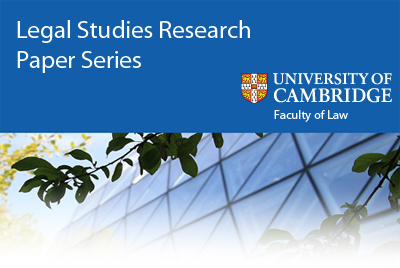 The Faculty has published Volume 7 Number 13 of the University of Cambridge Faculty of Law Legal Studies Research Paper Series on SSRN.
The Faculty has published Volume 7 Number 13 of the University of Cambridge Faculty of Law Legal Studies Research Paper Series on SSRN.
This issue includes the following articles:
Stefan Theil: Introducing the Environmental Minimum (53/2016)
This paper will present the core argument in favour of establishing the environmental minimum as a framework for the relationship between the protection of the environment and human rights. In simplified terms, the environmental minimum seeks to protect those basic environmental conditions that are necessary for the meaningful enjoyment of human rights, chiefly by providing a framework that fosters an active engagement with environmental degradation, its regulation and enforcement.
David Erdos: Beyond ʽHaving a Domesticʼ? Regulatory Interpretation of European Data Protection Law and Individual Publication (54/2016)
Statutory Data Protection Authorities (DPAs) who act as the guardians of data protection across the European Economic Area (EEA) have faced unprecedented interpretative challenges as a result of the explosion of indeterminate publication by individuals in the form of blogs, social networking and other online forums. Through both a questionnaire and systematic review of EEA DPA websites, this paper finds that these regulators have general adopted a strict interpretative of the law here, although considerable internal variation is also present. Almost all see data protection as engaged, around half argue that publication in the general social networking context requires data subject consent and even when individual publication is targeted towards the collective public many DPAs demonstrate some reluctance to apply the special expressive purposes (aka the journalistic) derogation. The paper argues for an alternative tripartite approach under the forthcoming Regulation which better and more consistently accommodates the competing free expression rights and also the limited capabilities reasonably to be expected of private individuals. The law’s personal exemption should cover individual publication so long as this does not pose a serious prima facie risk to privacy or other fundamental data protection rights. The special expressive purposes derogation should protect individuals who are disseminating a message to the collective public without discrimination. Finally, the Regulation’s new freedom of expression clause should ensure that individual publication which principally instantiates self-expression is subject only to the core of data protection’s substantive and supervisory provisions.
Kathleen Liddell: Immorality and Patents: The Exclusion of Inventions Contrary to Ordre Public and Morality (55/2016)
Ethical issues implicitly permeate all aspects of patent doctrine, including definitions of invention, novelty, inventive step, utility, disclosure and so forth. Interestingly, and in addition, many patent systems allow explicit ethical objections. This is most notable in the European Patent Convention (‘EPC’) which states at Article 53(a) that:
‘European patents shall not be granted in respect of inventions the commercial exploitation of which would be contrary to “ordre public” or morality.’
In broad terms, this provision means that patent protection is denied to immoral inventions, no matter how novel or inventive the invention may be. Intriguingly, it requires lawyers (including patent examiners and judges) to define morality. Recent cases concerned the morality of commercially exploiting mammals genetically programmed to develop cancer (Harvard Oncomouse) and stem cells obtained from human embryos (WARF and Brüstle). These raised difficult questions about genetic engineering, animal experimentation, the moral status of embryos, the morality of patenting animals and parts of the human body. With such troubling ethical issues in the frame, it is not surprising that Article 53(a) itself has proven highly controversial.
The principal difficulty is how to implement such a rule. How does a patent examiner or court assess whether an invention is immoral to the point that, unlike other inventions, it should not be granted patent protection? It is a question that runs headlong into the complex intersection of law and morality or, put another way, the intersection of intellectual property and philosophy.
Section III explains some of the contentious issues in the interpretation of Article 53(a). In light of these issues, many authors and patent practitioners have thrown their hands in the air in frustration, suggesting that the problems are insurmountable and that patent law would be better off abandoning the explicit morality exclusion. In the meantime they tend to interpret the provisions in a highly legalistic and usually narrow way, dissecting the words of the statute in fine detail. Often the words might be ascribed more than one meaning, but alternative interpretations are swept away for a legally plausible, but normatively doubtful, reason leaving the decisions mired in controversy and cast adrift in interpretative uncertainty. In contrast there is very little discussion of what might be the jurisprudential underpinnings of a morality exclusion in the patent system. This is considered briefly in Section IV and leads into the main contention of this chapter.
The principal argument is that a better appreciation of the nature and purpose of the immorality exclusion provides some vital clues as to how it should be interpreted (Section V). More specifically, it will be argued, building upon Burk and Lemley’s seminal paper in 2003, that the explicit morality exclusion is a ‘policy lever’, similar to the thirteen already identified in their paper, which tailors patent law to its overarching utilitarian objective of promoting socially beneficial inventions in a manner compatible with fair and just social organisation. As such, the explicit morality provision is a valuable opportunity to optimise patent policy, and an advisable inclusion in all national patent systems. Countries like the US which lack an explicit morality provision are disadvantaged by its omission. The exclusion calls for policy analysis, which requires more normative input by judges (and patent examiners) than linguistic textual analysis, but considerably less than a search for moral truth. It is thus well within the ordinary duties and capabilities of skilled legal decision-makers, who appreciate that law sensibly leaves discretion for judges (and other decision makers) to develop and shape the law in ways that promote desirable goals and behavior. This is not to say that this is how the immorality exception has been used to date, but rather how it could be used in the future.
Sections V and VI also discuss some of the implications of seeing the explicit morality exception as a policy lever. Section V revisits the debates in the literature, and Section VI considers the topical issue of embryo stem cell patents. These comments are necessarily general rather than detailed or prescriptive. More definitive answers require a more fine-grained case-by-case analysis, which the judiciary and examiners would need to tackle in any given case. And although it might be tempting to argue that judges and patent examiners should not be given such an active role in shaping economic and social policy, the fact is that they are doing it at the moment, and it would better that they do it consciously and critically, rather than inadvertently or furtively.
Sarah Worthington: Exposing Third-Party Liability in Equity: Lessons from the Limitation Rules (56/2016)
This article provides a re-examination of third-party liability in equity. The exercise was prompted by a difficult case on limitation periods in equity, but the conclusions – if correct – have far wider significance. Three major points are made. First, it has long been conceded that the language of constructive trusts and constructive trustees is confusing. It is suggested here that the language disguises a relatively straightforward search for situations where there are property splits (trusts) or property management responsibilities (fiduciary responsibilities). Secondly, accessory liability in equity looks to be something of a misnomer, since it appears that the drive is not to find individuals with particular associations with the wrongdoer and shared liability for the primary wrong, but instead to find individuals who are themselves trustees or fiduciaries because of their particular association with the original managed property. Liability follows accordingly, and is primary not secondary liability. Finally, where there are fiduciary responsibilities for property management, liability is in two forms: compensation for loss to the managed assets; and disgorgement of disloyal gains. The former is distinguishable from common law compensation in its focus on remedying loss to the property fund, not the loss to individuals interested in the fund. These insights – in particular the fiduciary characteristics of third parties in equity, and the workings of equitable compensation – have significant practical consequences.
Interested readers can browse the Working Paper Series at SSRN, or sign up to subscribe to distributions of the the e-journal.


 Facebook
Facebook  X/Twitter
X/Twitter  Instagram
Instagram  YouTube
YouTube  Flickr
Flickr  LinkedIn
LinkedIn